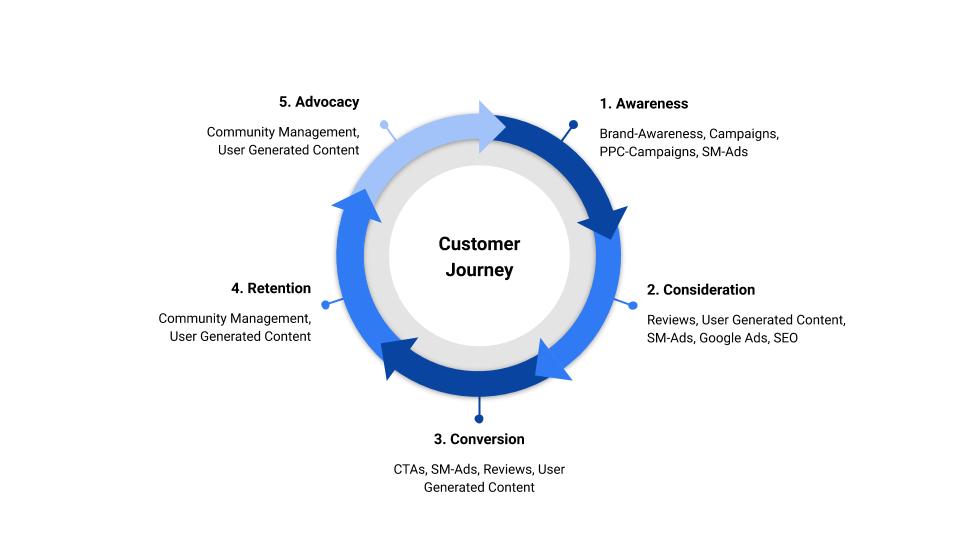Do you have thousands of content ideas and don’t know where to start? Don’t worry, we’ll show you how to perfect your content planning strategy and implement content ideas efficiently. Our checklist will help you coordinate your content in 6 steps and optimize your social media performance. From finding the right topic to creating an editorial plan, we’ll show you the most important steps for successful content planning.
Content-Checklist
1. Set up a style guide
Define what the external communication of your company should look like. Are you aiming for a personal level or a formal level? Maybe you want to appear as an advisor or maybe as a good friend? This is where you should create concrete guidelines on the tone of voice, spelling and grammar you will be using. That way you can be sure your future content reflects the language of your target group and is linguistically consistent across all your channels and formats, ensuring that your content is recognisable.
2. Run a content audit
The content audit is like an inventory and specific review of all your content and forms the foundation of your content planning strategy. This allows you to optimize existing content, identify content potential and finally improve your customer experience. Just follow these 3 steps:
- Quantitative Content Audit: Review your content and get an overview by tabulating it.
- Qualitative Content Audit: Rate your content according to specific criteria, depending on your focus, e.g. topicality or relevance. That way you will be able to identify potentials and weaknesses.
- Content Optimization: Determine which content remains unchanged, which should be updated or optimized, and which will be deleted.
Auditing your content will give you valuable information about your existing content and what needs to be done to improve the performance of your marketing efforts.
3. Research Topics
What do you want to talk about? Make sure your content follows a clear structure and that published content addresses your target audience. Clearly structuring your topics e will also help you to decide whether a piece of content is fit for your media channel or not. Use these sources for research :
- Target websites relevant to your audience
- Conclusions from the content audit
- Keyword based research
- Editorial research of topics
- Suggestion based search
- Social media
Discover current trends and the most relevant topics
With Fanpage Karma you can find the most relevant content from your networks, top topics and most interactive posts. Try it for free now!

After doing your research, compare the ideas with your goals and ask yourself:
- Do the topics match your goals?
- How great is the keyword potential of the topics?
- Is the topic large enough/too large for an article?
- Does the topic address the needs of your target audience(s)?
A good example for this is the travel provider Holiday Pirats. Because of the Coronavirus pandemic, traveling is limited. So Holiday Pirates now regularly share articles on the topic “How beautiful Germany is” on their german Instagram account. In their posts Holiday Pirates compare German to international travel destinations to show how attractive German destinations can be. This topic, targets all German travel enthusiasts who still want to travel in their own country even under current travel restrictions. They created a topic with great content potential, attracting the interest of the followers providing added value through its visual appeal. The Instagram post above received 9.300 likes and 351 comments. After seeing this post, is there anyone who doesn’t want to plan their next holiday?
Optimize your content strategy
This article will help you to set successful goals for your content strategy according to the SMART principle https://blog.fanpagekarma.com/2020/02/28/how-companies-should-post-content-social-media-marketing-guide/
4.Set up your customer journey
Think of ways your content can reach your target group. The times where you focus on only one platform in online marketing are over. Nowadays you have to reach out on multiple social networks – only one is usually not enough.
Your social media presence will help you reach out to different target groups and recognize behavioral patterns. The customer journey can be divided into five different stages:
- Awareness: The person recognizes a necessity or problem, becomes aware of your solution and develops an interest.
- Consideration: The person thinks about your offer and collects more detailed information and starts making comparisons.
- Conversion: The person chooses your offer.
- Retention: The person is satisfied and convinced to have made the right decision.
- Advocacy: The person is so satisfied that he/she begins promoting your product.

The Customer Journey will help you align your social media presence with your target group. Here is an example on how you can operate in the different phases.
- Awareness: Brand awareness campaigns help you obtain attention of relevant users that have never heard of you before. Using PPC (Pay-Per-Click) campaigns such as Facebook advertisements can also be extremely effective in bringing your offers to your target audience.
- Consideration: Many users research online before deciding for an offer. The amount of people using social media to get informed is constantly increasing. This is why you should use reviews and testimonials to convince your target group. Share them on your social media platforms.
- Conversion: Create content with a clear call-to-actions that convinces your target audience to choose your offer. Using user-generated content on your social media platforms or your own website works great.
- Retention: Even after someone has decided to chose your offer, it is important to keep an eye on your customers. Creating an online community helps to build a long-term customer retention. It is very important to react to comments, reactions and complaints on social networks. Increasing customer retention can help increase your reach and awareness.
- Advocacy: Social media can help build customer retention and maintain regular customer contact. It also makes it easier for your users to become promoters and share their own posts of your offer. This gives you the opportunity to share user-generated content and publish content from the community to increase customer retention and loyalty.
Keep an eye on your audience. Which stage of the customer journey are they joining your networks at? This will help you strategically align your content to the phase your customers are at and convince them.
5. Start with an editorial plan
An editorial plan will help you keep track of your entire content. Creating an editorial plan, allows you to clearly organize your content by format, channel and stage of your customer journey. In addition, you can also clearly display when, where and on which channels individual content is published.

The editorial plan will assist you with your monthly planning and will give your team and yourself an overview of your daily content management. We recommend to include certain points to your editorial calendar:
- Topics and keywords of the posts
- Content types (graphics, video, GIF, memes, etc.)
- Responsibilities for single content pieces
- Channels on which the content will be published
- Status information of your content pieces
You can download our free editorial plan template for 2020 here!
6. Time to measure your success
Successful content planning includes content analysis. Your actions must be measurable in order to evaluate them qualitatively and adjust them if necessary. Make sure to link your goal to concrete key figures. For example, is your goal…
- to improve user activity on your social media platforms, you need to know the exact amount of comments, likes, shares, and the reach of your posts
- to increase the traffic to your social media platforms then your page impressions, engagement, and reach will help evaluate
- to focus on generating leads, lead figures can be used
To analyse your content, make sure to use the right tools and assign responsibilities within the team. That way figures and goals can be reviewed regularly.

For the beginning the internal tools of the social media networks should be enough. For example, Facebook, Twitter, Instagram and LinkedIn provide you with extensive statistics, especially data on reach and engagement. If you want more information to measure the success of your social media presence, tools such as Fanpage Karma will help you to track all performance indicators you need and create detailed reports. Depending on your objectives, web analytics systems such as Google Analytics can help you collect data on traffic increase, visitor retention, lead generation, etc. and to check the impact of your social media activities on reaching your goals.
Analyze in real time
You want to learn content analysis in real time with Fanpage Karma? Here you’ll find out more https://blog.fanpagekarma.com/2019/01/30/how-to-analyze-in-real-time/
Conclusion
Content planning is the key to successful online communication. Whether your planning is internal or external, creating target group specific and relevant content requires structured planning. Make sure that your content always offers a value and benefits your target group. The editorial plan will help you improve and organize yourself and your team. It will also give you an overview of all your content.
Use our editorial plan now and start planning your company’s content. You can download our template for your editorial plan for 2020 here for free!
Optimize and automate your social media management
If you would like to track your success, automate your posting or manage all your social media pages over one tool, then try Fanpage Karma for free.



